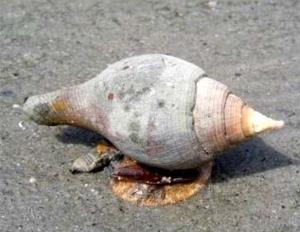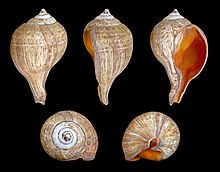Turbinellidae
| Turbinellidae | ||||||||||||
|---|---|---|---|---|---|---|---|---|---|---|---|---|

|
||||||||||||
| Systematics | ||||||||||||
|
||||||||||||
| Scientific name | ||||||||||||
| Turbinellidae | ||||||||||||
| Gray , 1854 |



The Turbinellidae are a family of mostly large to very large, exclusively marine snails that occur worldwide in tropical oceans, mostly in shallow water, some species also in the deep sea. The representatives of the family are predators , which differ from annelids and spray worms feed.
features
The thick and heavy, double-conical to spindle-shaped housings of the Turbinellidae have a short to long siphonal canal and a rough surface, often with knots and spines that run helically and are oriented towards the apex. The inner lip of the case mouth usually has strong folds. The columella can be smooth or have a few helical folds at the base. The housings are often reddish in color. The operculum is horny, thick and conspicuously claw-shaped with a terminal core.
The snails have a small head with a long proboscis and antennae, at the base of which the eyes are outside. The foot is broad and sometimes bilobed in front.
The animals are separate sexes with internal fertilization. The eggs are laid in ribbons or braids of thick egg capsules. In all Turbinellidae investigated to date, the embryos in the egg capsules develop into finished snails.
Way of life, occurrence and distribution
The Turbinellidae are distributed worldwide in tropical and subtropical seas. They live in the marine environment on coral reefs , gravel or sand. The Turbinellidae species are carnivores that feed predominantly or exclusively on polychaetes and syringe worms .
The Turbinellidae include the Turbinella angulata , which lives in the western Atlantic , Turbinella laevigata on the coast of Brazil , the real pear snail ( Turbinella pyrum ) in the Indo-Pacific and the great trunk snail ( Syrinx aruanus ) on the Australian coast , with a shell length of up to 91 cm largest snail species in the world. The vase snail genus ( Vasum ) includes the species Vasum turbinellus and Vasum ceramicum , which are widespread in the Indo-Pacific, Vasum rhinoceros living on the coast of East Africa and Vasum muricatum in the Caribbean and the rather small species Vasum globulus with a shell length of up to 4 cm .
Systematics
According to Bouchet and Rocroi (2005), the Turbinellidae family is one of twelve recent families in the Muricoidea superfamily . They divide the Turbinellidae family into four subfamilies:
- Columbariinae Tomlin, 1928
- Tudiclinae Cossmann, 1901
- Turbinellinae Swainson, 1835
- Vasinae H. Adams & A. Adams, 1853
literature
- Philippe Bouchet & Jean-Pierre Rocroi: Part 2. Working classification of the Gastropoda . Malacologia, 47: 239-283, Ann Arbor 2005 ISSN 0076-2997
- Winston Ponder & David Lindberg, Towards a phylogeny of gastropod molluscs; an analysis using morphological characters . Zoological Journal of the Linnean Society, 119: 83-265, London 1997 ISSN 0024-4082
- Frank Riedel: Origin and evolution of the "higher" Caenogastropoda . Berliner Geoscientific Abhandlungen, Series E, Volume 32, Berlin 2000, 240 pages, ISBN 3-89582-077-6 .
Web links
- Turbinellidae Family - Vases & Spindles. Portal snails and clams
- JM Poutiers: Gastropods. In: Kent E. Carpenter, Volker H. Niem (Eds.): FAO Species identification guide for fishery purposes. The living marine resources of the Western Central Pacific. Volume 1: Seaweeds, corals, bivalves and gastropods. Food and Agriculture Organization of the United Nations, Rome, 1998, on Turbinellidae: pp. 603-606 ( online: Vol. 1 (PDF, 43mb)).
- Turbinellidae in the Integrated Taxonomic Information System (ITIS)
- Animal Diversity Web
- Turbinellidae. Picture gallery at the Natural History Museum Rotterdam
Individual evidence
- ↑ Helena Matthews-Cascon, Cristina de Almeida Rocha-Barreira, Carlos Meirelles, Gregorio Bigatti, Pablo Penchaszadeh (2009): Description of the Ootheca of Turbinella laevigata (Mollusca, Gastropoda) (PDF; 1.8 MB) . Brazilian Archives of Biology and Technology 52 (2), pp. 359-364.
- ↑ John D. Taylor, Emily A. Glover: Food of giants - field observations on the diet of Syrinx aruanus (Linnaeus, 1758) (Turbinellidae), the largest living gastropod ( Memento of July 21, 2011 in the Internet Archive ) (PDF; 306 kB). In: FE Wells, DI Walker and DS Jones (Eds.): The Marine Flora and Fauna of Dampier, Western Australia. Western Australian Museum, Perth 2003.